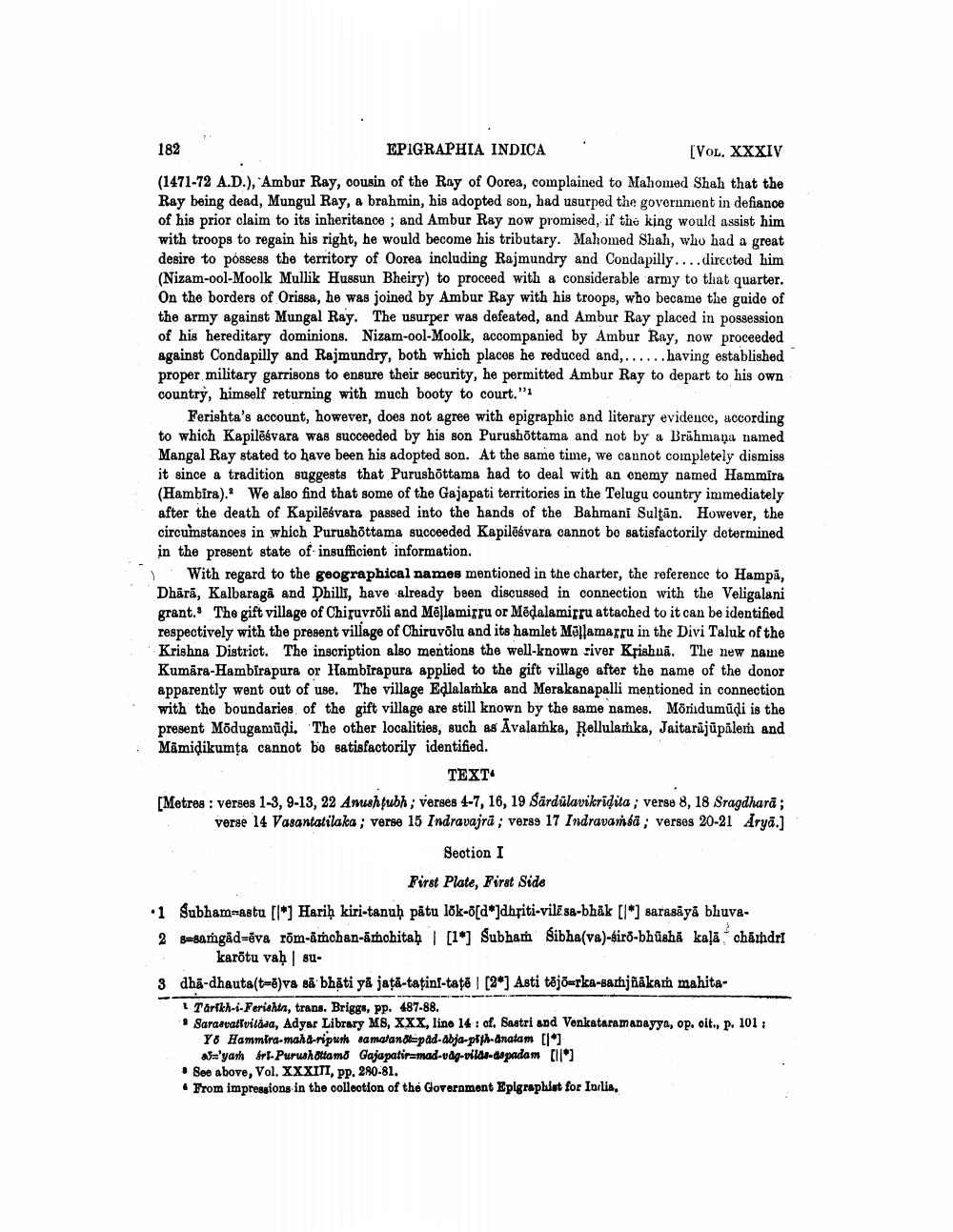________________
182
EPIGRAPHIA INDICA
[VOL. XXXIV (1471-72 A.D.), Ambur Ray, cousin of the Ray of Oorea, complained to Mahomed Shah that the Ray being dead, Mungul Ray, a brahmin, his adopted son, had usurped the government in defiance of his prior claim to its inheritance; and Ambur Ray now promised, if the king would assist him with troops to regain his right, he would become his tributary. Mahomed Shah, who had a great desire to possess the territory of Oorea including Rajmundry and Condapilly....directed him (Nizam-ool-Moolk Mullik Hussun Bheiry) to proceed with a considerable army to that quarter. On the borders of Orissa, he was joined by Ambur Ray with his troops, who became the guide of the army against Mungal Ray. The usurper was defeated, and Ambur Ray placed in possession of his hereditary dominions. Nizam-ool-Moolk, accompanied by Ambur Ray, now proceeded against Condapilly and Rajmundry, both which places he reduced and,......having established proper military garrisons to ensure their security, he permitted Ambur Ray to depart to his own country, himself returning with much booty to court."1
Ferishta's account, however, does not agree with epigraphic and literary evidence, according to which Kapilēśvara was succeeded by his son Purushottama and not by a Brahmaṇa named Mangal Ray stated to have been his adopted son. At the same time, we cannot completely dismiss it since a tradition suggests that Purushottama had to deal with an enemy named Hammira (Hambira). We also find that some of the Gajapati territories in the Telugu country immediately after the death of Kapilesvara passed into the hands of the Bahmani Sultan. However, the circumstances in which Purushottama succeeded Kapileévara cannot be satisfactorily determined in the present state of insufficient information.
With regard to the geographical names mentioned in the charter, the reference to Hampa, Dhārā, Kalbaraga and Dhilli, have already been discussed in connection with the Veligalani grant. The gift village of Chiruvroli and Mellamirru or Medalamirru attached to it can be identified respectively with the present village of Chiruvõlu and its hamlet Mallamarru in the Divi Taluk of the Krishna District. The inscription also mentions the well-known river Krishna. The new name Kumara-Hambirapura or Hambirapura applied to the gift village after the name of the donor apparently went out of use. The village Edlalamka and Merakanapalli mentioned in connection with the boundaries of the gift village are still known by the same names. Mõridumüdi is the present Mōdugamudi. The other localities, such as Avalamka, Rellulamka, Jaitarājūpālem and Mamidikumța cannot be satisfactorily identified.
TEXT'
[Metres : verses 1-3, 9-13, 22 Anushtubh; verses 4-7, 16, 19 Särdülavikridita; verse 8, 18 Sragdharā; verse 14 Vasantatilaka; verse 15 Indravajra; verse 17 Indravamsa; verses 20-21 Arya.]
Section I First Plate, First Side
•1 Subham-astu [*] Hariḥ kiri-tanuḥ pātu lõk-ō[d*]dhriti-vilēsa-bhāk [*] sarasāyā bhuva2 s-saṁgād=ēva rōm-amchan-amohitaḥ | [1] Subham Sibha(va)-śirō-bhūshā kaļā chamdrī
karotu vaḥ su
3 dha-dhauta(t-ě) va sa bhati ya jaṭā-tațini-tatē | [2] Asti tējō-rka-samjñākam mahita
Tarikh-i-Ferishta, trans. Briggs, pp. 487-88.
Sarasvativitása, Adyar Library MS, XXX, line 14: of. Sastri and Venkataramanayya, op. cit., p. 101:
Y8 Hammira-maha-ripum samatano-pad-abja-pith-anatam [*]
85-'yam bri-Purushottamo Gajapatir-mad-vag-viläs-aspadam [||]
See above, Vol. XXXIII, pp. 280-81.
From impressions in the collection of the Government Epigraphist for Iulia,
لیے




